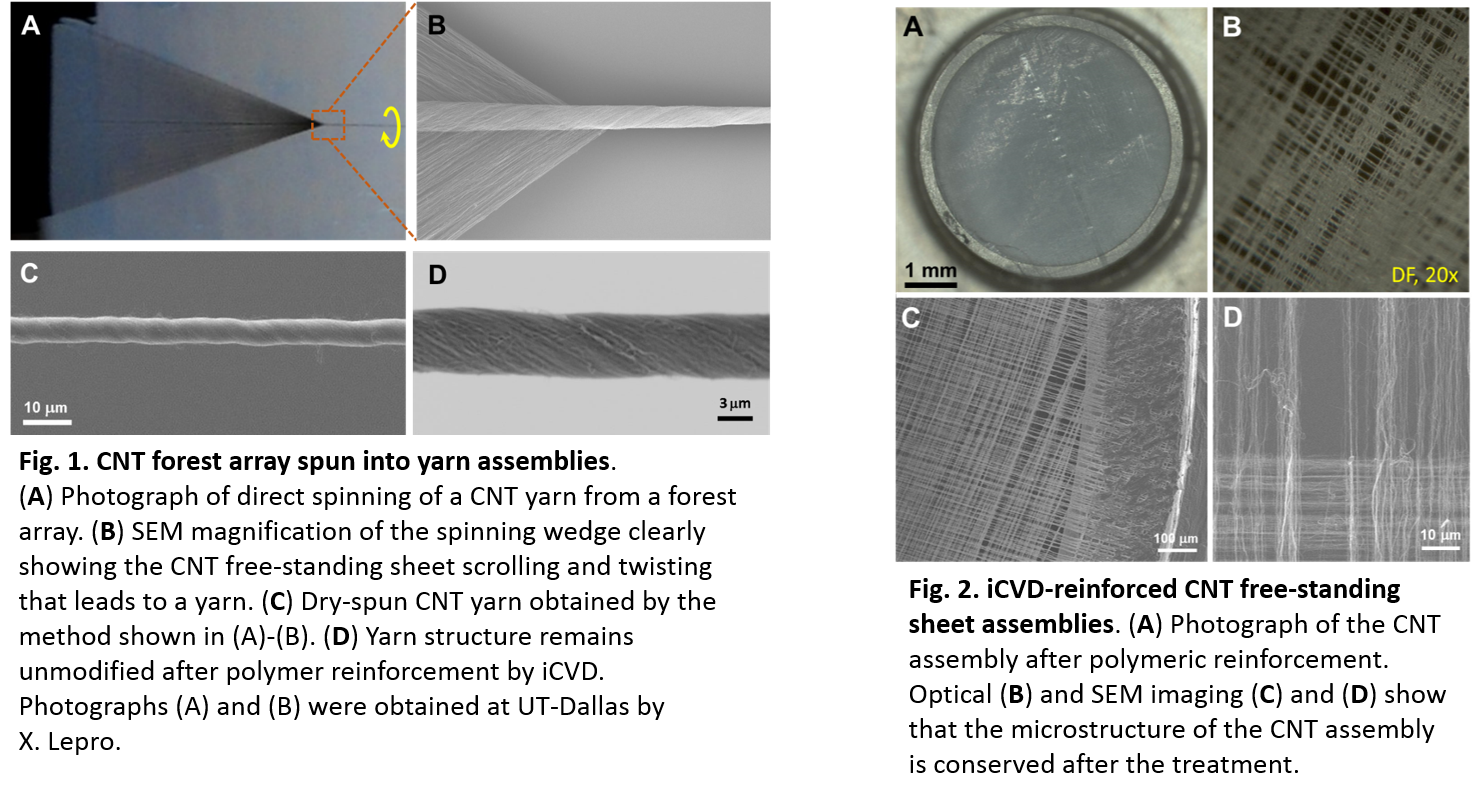High specific strength and thermal conductivities of individual carbon nanotubes (CNTs) makes them attractive to develop high performance materials. Techniques such as direct CNT sheet drawing and spinning from morphology-tuned vertical CNT arrays are possible because their inherent self-assembly property that induces nanotube bundle orientation parallel to a given pull direction. Such produced carbon nanotube aerogels are mechanically strong while still exhibiting air-like volumetric densities. Upon twisting or spinning, drawn sheets can be transformed into flexible, micrometric-thin yarns with a microstructure resembling the one of wool or cotton threads used in the textile industry. Since mechanical entanglement and other non-covalent interactions such as van der Waals forces are the responsibility of CNT self-assembly, material failure is driven by nanotube slippage rather than by the breaking of the covalent carbon-carbon bonds forming individual CNTs.
As a result, CNT self-assembled materials while strong, are still weaker than individual nanotubes. Stronger structures can be obtained by strengthening the interconnecting linkage points among independent nanotubes by covalently bonding. However, such process involves chemical functionalization of individual CNTs which involves harsh conditions like hot strong acids or oxidizers or highly energetic plasmas are detrimental to the CNT properties. Other strategies like traditional polymer reinforcement of CNT structures, while successful in increasing the overall strength of spun-yarns, may not necessarily produce a covalent bond between the polymer and nanotubes which is required for an efficient load transference. Solution-based techniques for polymer reinforcement may collapse free-standing structures other than yarns (such as free-standing sheets) by the forces exerted by surface upon solvent evaporation or matrix densification.
LLNL has developed a liquid-free method that increases the overall mechanical resistance of self-supported, carbon nanotube assemblies through nanoscale reinforcement by gas-phase deposition of a thermally cross-linkable polymer. Polymer-reinforcement increases the strength of CNT yarns after crosslinking. For example, a minimal amount (<200 nm) of poly-glycidyl metacrylate (PGMA) deposited on the yarn, is enough to increase its Young's modulus to values ≥20 GPa.
Free-standing sheets of preferentially aligned CNTs are manufactured by pulling from the edge of CNT arrays (or forests) produced by chemical vapor deposition. Yarns are produced by either inserting twist into pulled CNT sheets or by direct spinning (twisting while pulling) from forests (fig. 1A-B). Inter-nanotube distance in yarns can be reduced by wet-densifying them by immersion or exposure to suitable solvents (e.g. alcohol, acetone, etc.).
CNT free-standing sheets assemblies are prepared by placing individual CNT sheets on top each other in orthogonal direction or any other rotated angle on an open support (fig. 2A). Inter-nanotube distance can be minimized by exposing the sheet assemblies to a mist or aerosol of a solvent or mix of solvents (e.g. alcohol, acetone, etc.).
Following preparation, the carbon nanotube-based samples (yarns or sheets) are placed into a filament-heated low-vacuum chamber (iCVD reactor) and exposed to typical polymerization conditions for PGMA. After deposition, PGMA coated-CNT samples are thermalized in inert atmosphere (N2) to temperatures ranging 120-200°C to induce the self-crosslinking of PGMA. The resulting crosslinked PGMA-coated CNT self-assembled arrays (fig. 1D and 2) are chemically and mechanically stable under room conditions of humidity and light.
S. Baxamusa, X. Lepró, T. Lee, M. Worthington, P. Ehrmann, T. Laurence, N. Teslich, A. Suresh, D.D. Burkey; "Initiated chemical vapor deposition polymers for high peak-power laser targets". Thin Solid Films 2017, 635: 37-41.
This method for polymer reinforcement of carbon nanotube yarns and aerogel sheets does not induce their structural collapse. CNT assemblies retain their shape after the process and can be handled without additional provisions to the ones already used for untreated materials.
Porous carbon yarns and sheets with high tensile strength may further find use as a new class of polymer composites, support for separation membranes and other mechanical/electrical conductive components.
These strong and lightweight carbon-based arrays may be used as capsule support materials required in the inertial confinement fusion (ICF) experiments performed at the LLNL National Ignition Facility.



